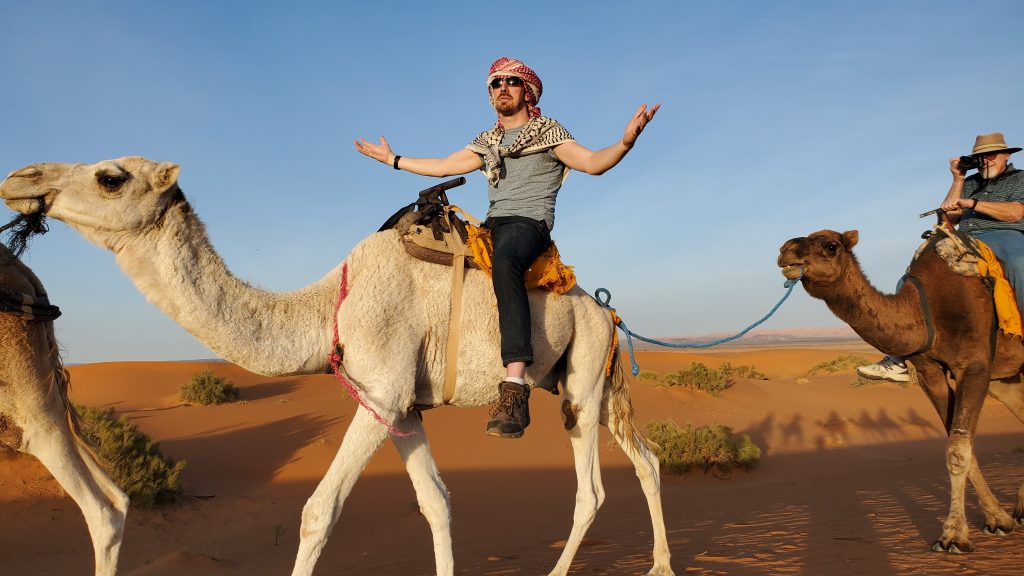
Our traveling home away-from-home/hotel for the next 10 days is a black, 12 seat Mercedes van. It rumbled contentedly up the High Atlas mountains, heading east, always east (and usually south) from Marrakech. We had been met at our hotel by Omar, with a close-trimmed black beard and mustache, baseball cap, and well-lined smiling face. A 48 year old freelancer hired by Odynovo, he was partnered with Yaseen the driver, a few years younger than me and also wearing braces, same as I’ve had for the past six months. Yaseen came with the van from a separate company too, but Omar told me that the two of them had worked together dozens of times over the past few years with small private tours. As his regular tour size was 45 people in a full-sized bus, hopefully we represent a less stressful and more relaxing tour for him, too.
The road we were on heading into the mountain switchbacks were well-maintained and recently paved, and as we paused to take pictures on a mountain vista overlooking the kilometers we had just traveled, I commented to Omar about the strange way the trees seemed to grow extensively on one part of a mountainside to our west, but then stop abruptly in almost a straight line. Omar, like our previous two guides before us, was quick to extol the wisdom of both the current king and the past one – a tree-planting initiative had been created by the monarchy and government in the past several decades almost exclusively using a special type of oak native to the Mediterranean region (I’d never heard of it; the waxy, water-retaining leaves look almost like holly, don’t they?) that would, in time, develop a deep root system, preventing erosion and rock-slides as well as improving the soil quality itself. While not yet everywhere, Omar thought large stands of these trees would eventually cover every public mountainside in the country.
We had a brief stop at a rug shop, a multi-village cooperative, on the other side of the mountain range. The small, salt-and-pepper bearded Berber sheikh introduced himself to our group as “Ali Baba” and like most of the others we’d met so far, launched into his explanation nee sales spiel with the practiced ease of a longtime businessman. At my request, he pointed to his wall-hung Certificate of Official Cooperative-ness from the government, and said that this shop he ran was owned by a dozen people together, and coordinated the distribution of wool from the widespread (about 50km worth of villages/families) shepherds to the weavers themselves, who mostly work at home, determined what patterns and designs to make this month, etc. There were 2 women working in Ali Baba’s shop while we visited, and he explained that the women would take turns coming in to demonstrate the process to tourists for a few weeks at a time. They smiled shyly at us as they rested from clacking at their vertical hand-looms, and one got up to serve us the ever-present mint tea. I asked them if working for a cooperative was a good job and they glanced at each other, nodded, and giggled. Their Arabic was limited, as they primarily spoke Berber, but Ali Baba helped translate from my English/bad Arabic to them.
The sizes of the carpets ranged from about a half meter square (“if you are looking for a post card?” Ali Baba laughed as he pointed them out) to the largest he and another male assistant spread before us, about 4×6 meters and intricately designed with lots of tight, close stitches and many colors. Ali Baba said that of course, the carpets made by less-experienced workers would have less-tight/close together threads and one could see more of the plain white “loom lines” (I’m sure there’s a proper word for it but I’m not a weaver) if you nudged the cloth hard with your finger, instead of the colored thread. He pointed to the huge carpet commanding the attention of the room. “This… golden fingered women!” he laughed, and gestured to a smaller piece that was off to the side, pulling at the threads. “This is copper fingers! Just starting out, but if she has patience and practice, she will get there.” Apparently all the weaving itself is done by women (“you know, ladies – men have no patience, right?”) but the shepherding and related farm work is done by the men. Unlike the women’s pharmacy cooperative in Marrakech, this was a holistic cooperative with work distributed between the two sexes.
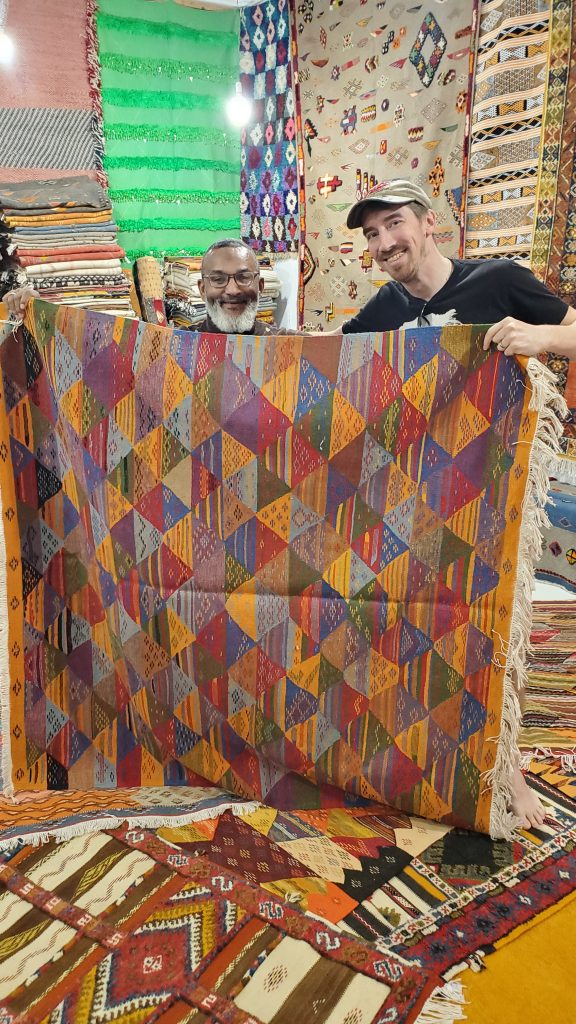
Lunch was at a heavily trafficked tourist restaurant in the village Ait Ben Haddou. Ait is a Berber word for tribe, so the full name is “The tribe of the sons of Haddou.” There were at least 3 busloads of people swarming about the numerous tables, and equally numerous, harried looking staff – lunch options were a prix fixe sets of soup/salad + pizza/tagine/couscous + fruit for dessert. Omar and Yaseen (we would learn now, and continue to see over the next few days) would generally not eat with us, disappearing elsewhere during meals and Omar would reappear magically just as we were ready to stand up. Therefore although we could see a tall hill to the northeast with a small structure atop it, and people walking all over said hill, we had no idea what it was. We knew there was supposed to be a centuries-old village, created from carefully daubed and packed mud and cane that was what we were visiting, but it wasn’t visible from this side.
After lunch, our three companions decided to head straight to the hotel, so my parents and I had a nice hour-long walk with Omar as he went into Tour Guide mode for us. We walked along meandering gravel paths from the restaurant toward the aforementioned hill, circling round it and there, Ait Ben Haddou came into view. It was indeed a unique sight. While we had been seeing milk-chocolate brown thick-walled buildings for several hours in this region, this was the largest collection of them yet, looking like they were built on top of each other with the optical illusion of the steep hill behind them. Many of the largest buildings also had simple but elegant pressed Berber symbols and motifs in repeating shapes around their crenelated tops. Omar told us that about a thousand people still lived in this ancient village, and another several hundred lived in the “new city” across the road from it. Unsurprisingly, luxury hotels for tourists were springing up all over this area and jobs were being created for the local Berber villagers (mostly) in them.
We learned that Ait ben Haddou and the nearest large city to it, Ouarzazate, were also internationally known due to their connection to the film industry, both of the USA’s but also France and others. From a cynical perspective, the local Berbers were inexpensive extras for multibillion dollar movie machines, yes. But on the positive side, they and their parents and even grandparents had been doing it for so long, they were also now in high demand for other reasons. Intelligent, patient, and extremely practiced, the Berber would also offer up their livestock and other animals to be extras as well, continuing to lend authenticity to background shots. The appearance of this region is similar to many areas of the American southwest, and to the average moviegoer, also any other part of the Arab world – or fantasy worlds. Some famous examples that had at least one scene here were Gladiator, Lawrence of Arabia, and the more recent Game of Thrones scenes that involved the city of Yunkai, one of the cities in Essos (not the main region Westeros) that is filled with enslaved people. Many of these enslaved characters were of course, played by the local folks of Ait ben Haddou. In Ourazazate there are sound stages and lots for recording that doesn’t need to be onsite, too.
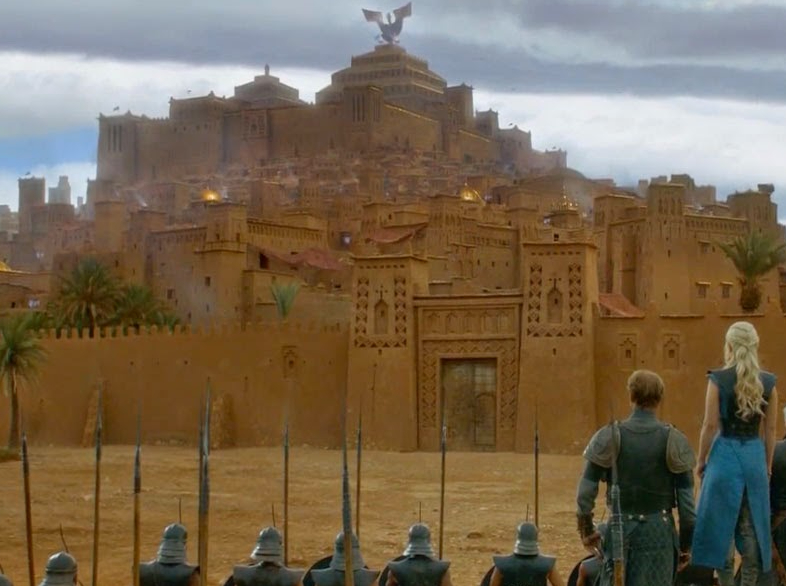
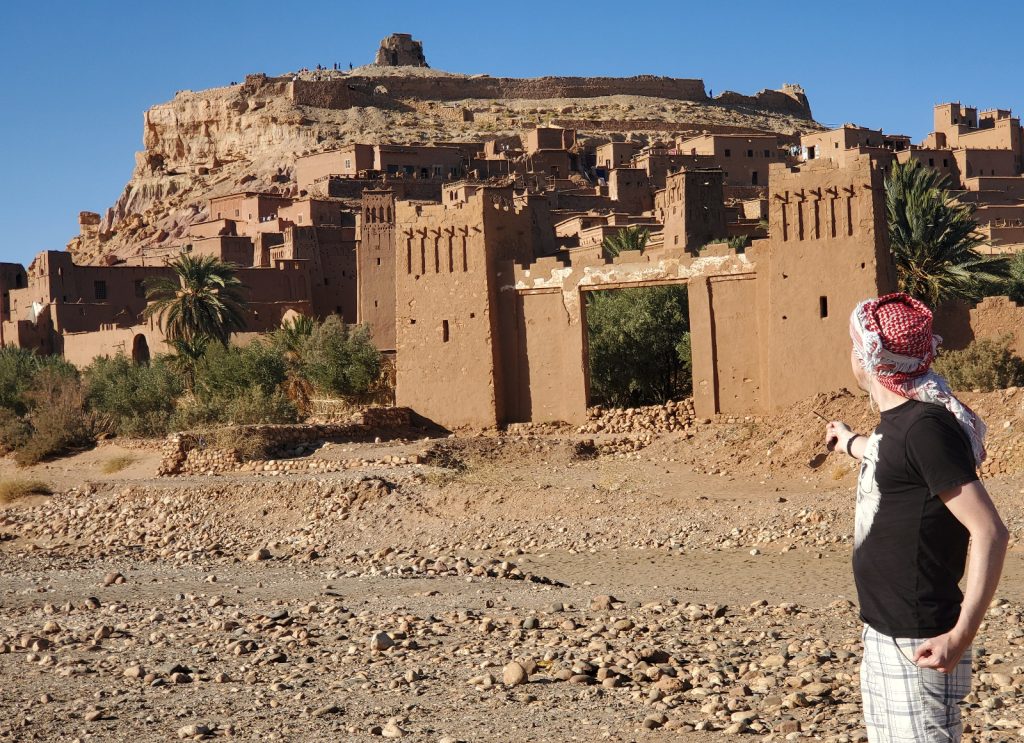
At the top of the hill we had seen from the restaurant, there was the ruins of a small building that we were told had once been larger, and used as, of course, a defensive fortification for villagers of the ancient to withdraw to during attacks. Being next to a river (currently just a trickle) that would periodically flood, having this high ground was useful to escape from that too. We could also see a second wider, but shorter hill a half kilometer away to the east that had a few trails on it leading into the dark mouths of caves, this was a storage location for food or anything else the tribe could want.
Omar led us back down the hill via a second route as I peppered him with questions about the Moroccan dialect compared with Levantine “Shami”. Luckily for me, he seemed entirely easygoing about it. He called Yaseen for our pickup; as the hotel we’d be staying at was, if not just across the road from us, only about 5km up the highway and a quick trip.
At the hotel, we were checked in by a blonde Arab woman from Marrakech, and when the dark-skinned lady next to her served us tea, I attempted to think her in Arabic, to which she did a double take at me and said something rapidly in French. I then replied in English saying I couldn’t understand her; did she speak Arabic? No, she replied – only French and a small amount of English; she was from Senegal. I guess not every hotel company in this area employs the local Berbers. But the other former French protectorates/colonies of Africa were able to find work up here in Morocco if they wanted.
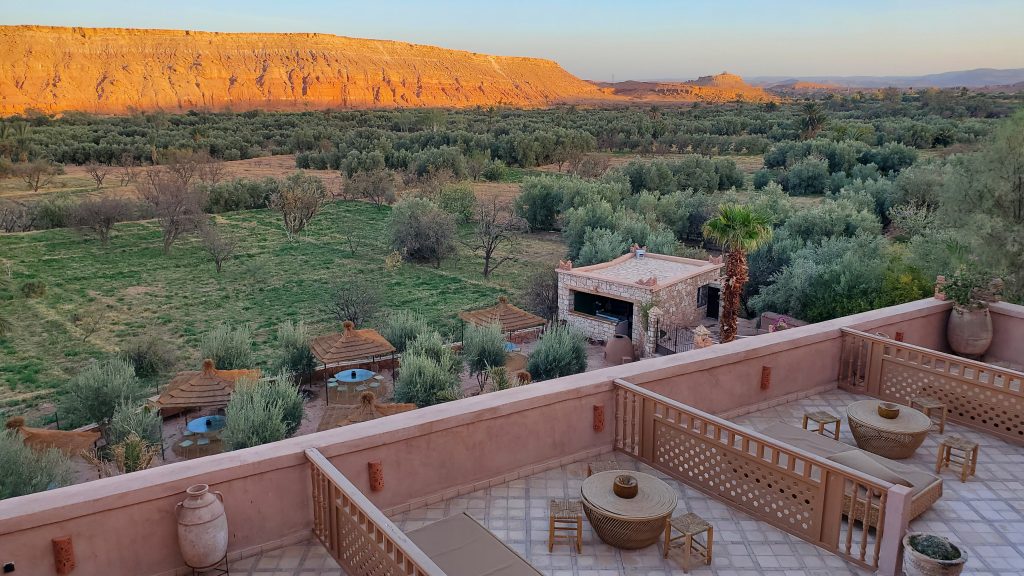
We passed a quiet night at the hotel after the included dinner (a tasty buffet; something we’d be seeing a lot of on this trip I’m guessing) and arose before dawn to continue heading eastward. We stopped in the city of Kalaat M’Gouna a few hours later. This entire region was known for the cultivation of various types of roses, with festivals celebrating them and industries dedicated to their use – drying them for rosehip tea, turning them into lotions, oils, and rosewater, and of course, simply enjoying their smell or appearance. I’ve mentioned in the past couple posts about how important roses are in Moroccan culture, used not just the way we do in the USA for expressions of romantic love, but also whenever you want to welcome guests in any capacity, be it for a hotel to their customers, or one Moroccan merely to have friends over for dinner. It was a short stop in the city as we still had a long way to drive, but Omar knew of a woman-owned cooperative here, Rosamgoun, where a young woman in spectacles and a hijab introduced herself as Zaynab and gave us a quick tour of the rose processing equipment onsite. Primarily, a huge drum with pipes and tubing running off of it. Nothing was currently being processed at the moment as it’s November and they’re just focusing on selling the products they made throughout the past year, but Zaynab told us their particular facility usually processes 100-200 tons of roses each spring; they have a small farm of their own that they grow Damascus Roses on (known for their scent, not their appearance), but they mostly then buy roses from other farms, and handle the processing of them into products.
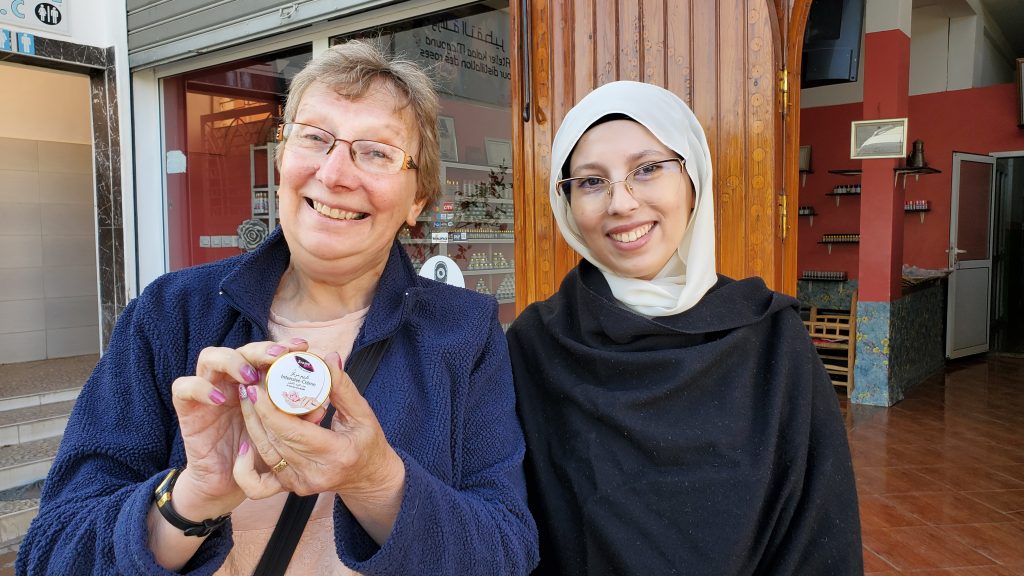
Continuing on into the mountains, we came to Todgha Gorge, an impressive natural wonder that we spent about 15 minutes inside. Huge, almost sheer cliffs towered over us, about 300 meters at least where we were at, creating what must be an almost permanent shadow, with a large, fast moving creek at the bottom. The gorge’s beauty was caused by a combination of first ancient earthquakes to create the initial crack and opening of springs in the prehistoric rock, followed by those springs gushing forth the water that would slowly but surely buzzsaw its way further through the mountain. I would have loved to have hiked in that gorge for hours; memories of my old “wadi walloping” days with my friends in Jordan running through my head – but we had to press on.
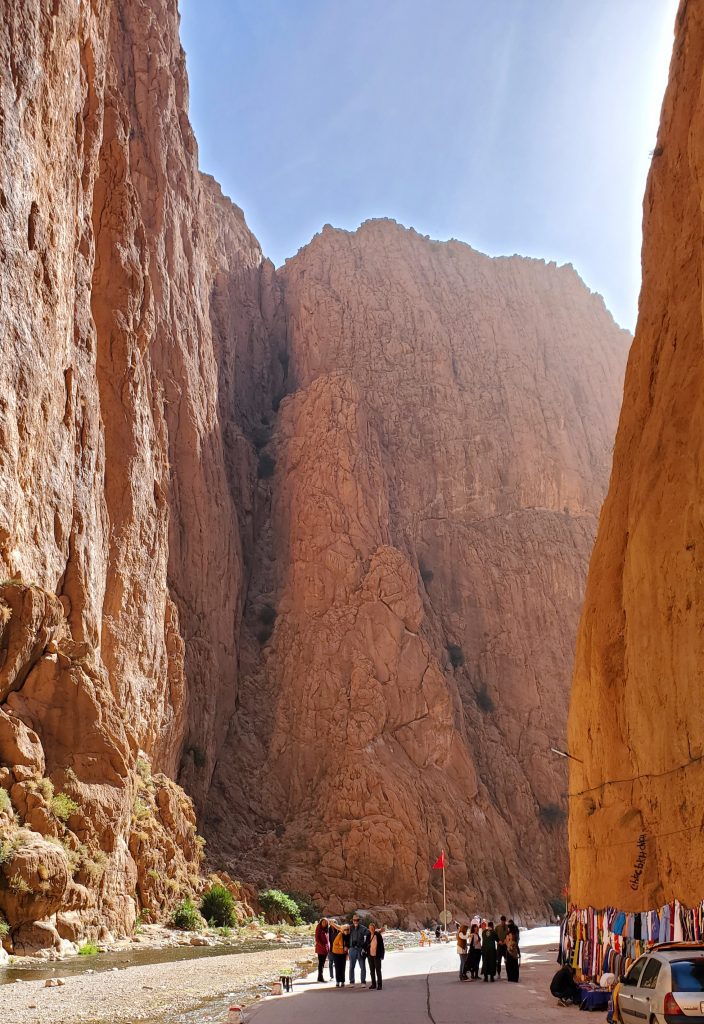
Finally, the sand dunes appeared on the horizon in front of us – huge and red as they caught the sun behind us to the west. These were the Erg Chebbi dunes, outside of the small town of Merzouga. They seemed to rise out of nowhere; the road we were driving on was more or less flat, with scrubby brush waving in the breeze above white-yellow sand and gravel, but the dunes ahead of us looked exactly what you would imagine when you think of dunes; not a tree on them (at least not visible from this distance, still 5-10 km away), and towering at least 100-300 meters above our van.
Speaking of the van, we’d need to leave that, and Yaseen, behind – where we were going, he could not follow. Omar and our group disembarked and were met by the wire-thin, somber-faced and turban-wearing Hussein and his companion – Berbers of the Ait Khabbash tribe. They each had a Toyota truck – a Hilux and a Forerunner – and our carry-on sized bags were loaded into them (checked-luggage sized bags were left with Yaseen). Our party was split in two with 3 guests in one truck, and 3 guests + Omar in the other. With a roar of engines coughing to life as their special sand-reducing filters struggled to suck in air without choking, the two men hit the gas and we spun offroad and into the Erg.
I was with Omar, my mother and Betsy, following the Forerunner driven by Hussein. He drove rapidly up over the side of some of the smaller dunes, at angles that I’m pretty sure I see with huge red X’s over them in the instruction manuals of riding lawnmowers. I commented to the ladies of my family that I hoped dad, in the front seat of Hussein’s bucking stallion, had a strong stomach – and was wearing his seatbelt in case the whole thing flipped over. Our own driver – whose name escapes me unfortunately; my memory isn’t perfect – chatted amiably with Omar and didn’t attempt the same sand stunts, probably to the great relief of Wendy and Betsy.
KamKam Dunes was the name of our destinations, at the northern foothills of the Erg. Omar broke into a large smile when we arrived after a fifteen minute drive – he had been telling us for the past two days how much he loved camping, and that seeing the sunset over the desert was one of his favorite parts of coming to this part of Morocco. We were almost exactly on the opposite side of his country; he was from Agadir, a western seaside city south of Essaouira, and now we were merely 15km from the Algerian border to our east; we could see the mountains separating the two countries clearly lit by the sun as it began to make its final burning descent toward the Erg dunes.
We hurriedly drank the offered tea and trundled down a slope toward our waiting chariots – 6 male camels, all sitting tethered in a row, staring off into space and sometimes farting contentedly. Thankfully, a cool desert breeze allowed the scents created by the furry dromedaries to waft off without abusing our noses too harshly! Half of our group – me and my parents – were already “experienced” camel riders in the sense we’d each spent at least three hours on them in the Wadi Rum desert of Jordan, and I’d also had another several crossing a small desert in northern India – but the other three weren’t quite so sure. Betsy was game for it, but Connie and Nicole had been ready to politely decline even until the minute we arrived at the camp, but after seeing how easygoing and gentle our Taxis of the Desert seemed to be, they agreed to give it a shot.
The caravan was loaded with their passengers from back to front, and the bandaid of nervousness was ripped off fast; Connie and Nicole were the first to load. Personally, I wished they would have let me do it first so as to reassure them; the feeling of a camel’s stilt-like legs extending beneath you – first the rear ones, so you pitch forward, yelping as you grab the metal horn in front of you, then the front ones, so you pitch backward slightly and regain your balance – can be well, disconcerting. I was the 2nd to last to load and lucky Betsy was the last – and therefore, our leader with the only view of our route ahead that didn’t involve at least 1+ camel rump and its (frequent) output.
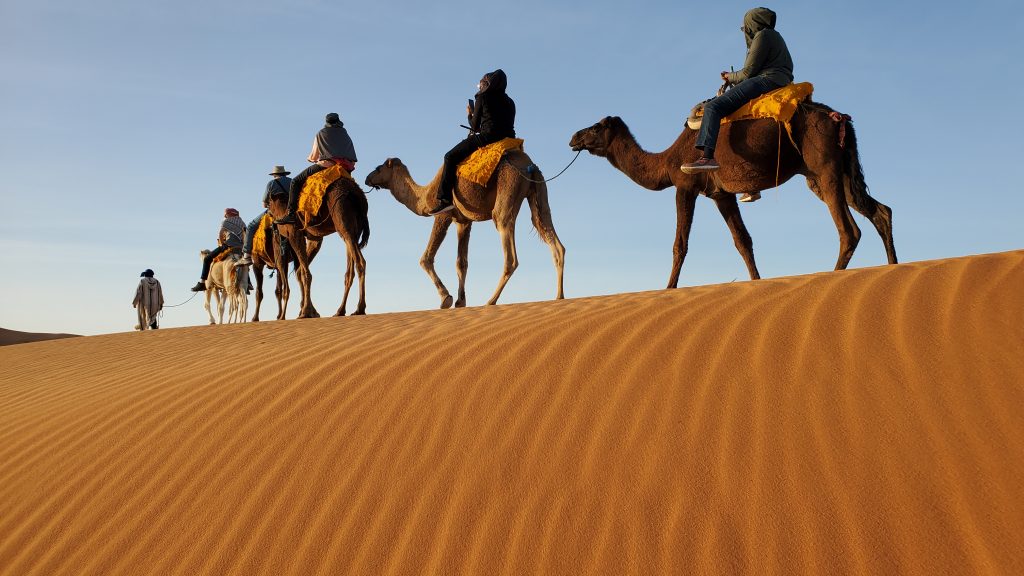
Our Khabbashi guides were very different. Mohammad was an eager 30 year old who acted as the official photographer for us all, reaching up to collect each of our cameras in turn and racing about the docile camels as they plodded steadily forward, taking pictures rapid fire. The other was Ibrahim, who led Betsy’s camel by its halter and told me that he didn’t know his age, but guessed he was between 50 and 60. Hussein spoke the most English of the group by far, and told me on the return drive the following day that only in the past couple decades had Moroccan government officials been able to properly track and register births here in the far reaches of the kingdom; when Ibrahim had been born, registrations were done only every half dozen years or so when personnel could reach an encampment; particular in the years before tourism increased to these high levels now and the Berbers, particularly the desert-dwelling Khabbash, were far more nomadic and hard to track down. Ibrahim barely spoke any Arabic at all and couldn’t read or write it either, but his competence with the camels was obvious. His face was heavily lined from decades of high sun exposure and his twinkling eyes seemed to be deeply pushed back into his head as if they were trying to protect themselves.
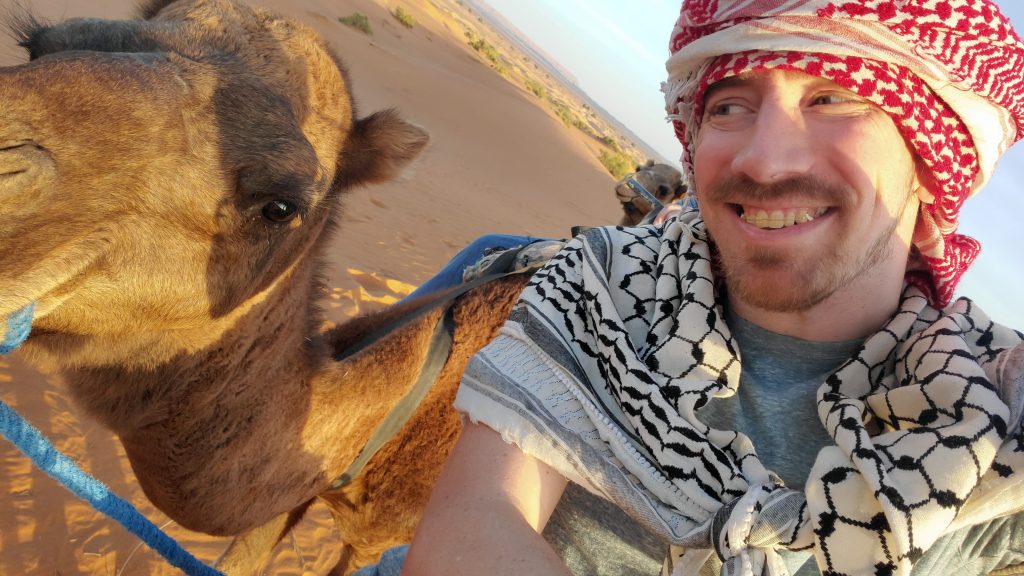
After about 30 minutes on the camels, during which the one my father was riding on just behind me nuzzled up against my shirt several times with a derpy smile upon its face, we reached a particularly flat dune that our duo of guides apparently liked, and dismounted – which is basically just as disconcerting as the previously described mounting, except in reverse. Once you remember what’s coming, it’s not so bad though. The sun was about 2 sun-widths from the dunes and everything was by now a deep, deep red from the reflections across the twinkling sand. Mohammad led us by foot another 5 minutes to a dune he liked, leaving the camels behind, and bid us to plop down on the very top of its narrow ridge, so our feet could comfortably sink into the slope below. Nicole found what I think was a dung beetle, (dungless at that moment, although there was plenty of the camel variety to be found) that despite its humble task, had a lovely iridescent sheen to its chitin. The sun silently hit the edge of the dunes before us as it had for eons preceding (well, when all this was underwater in an ancient sea, I guess it probably looked different then) and a chill breeze whipped up, as it tends to in the desert. We returned to our drowsy camels, reboarded without incident, and caravanned back to KamKam.
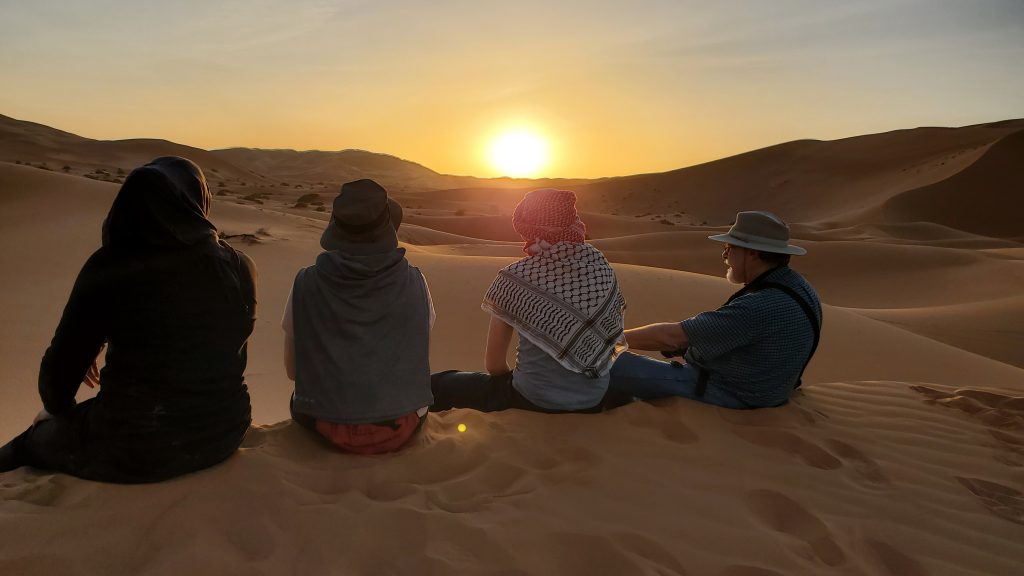
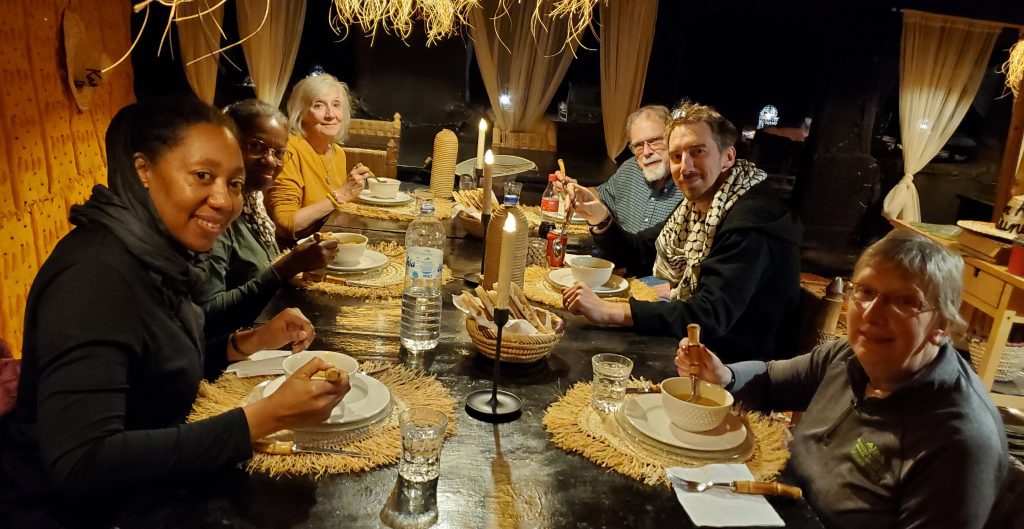
After an excellent multicourse dinner (it was nice to not do a buffet) of cold salads followed by chicken kebabs, meatballs (kefta), and french fries served to us by a fifth Berber we hadn’t yet met, we ducked out of the Meal Tent to see that the huge firepit had a (small) fire of olive wood lit in it, and the entire Merry Band of Berbers, six in all, were setting up a small musical set for us. Our car’s driver, the one who Wasn’t Hussein, turned out to be the musical prodigy of the group, playing a decidedly modern six-string electric guitar and singing into a lavaliere microphone, both of which were piped into a large amp he had rolled out next to him on a cart.
As an aside, as clearly I am not editing these things for length, I was impressed with the modernity of KamKam – as much as I loved my friend Suleiman’s Starlight Camp in Wadi Rum, both because of and in spite of its simplicity – this was a camp geared for luxurious tourism of a type I’d never experienced before, and I was told that this camp was just about average for luxury stays. They had banks of solar panels set up a hundred meters away from our group of tents, battery backup to power full 220v inverters for what they estimated was 3 hours after sundown – or maybe less, if your musical amp is putting out Sweet Licks at full blast. The sleeping tents were also the most decadent I’d ever personally seen before, like something out of Harry Potter or something. They were large, brown, and nondescript from the outside, but once the flap was unzipped each of us saw they were stark, professional white within, with a queen-sized bed, pillows, and a large endearingly-scruffy looking brown fuzzy blanket that looked like someone had prepared a buffalo pelt for each of us. Once again, flashbacks of nostalgia for Suleiman and his camp rose within me, as very similar looking blankets had been our nighttime warmers there as well.
Even more impressive (and telltale that these Khabbash and this tourist camp were nomadic no more) was the fully plumbed western toilet, two basin sinks inlaid with ammonite and squid fossils, and even a shower. While there were no electric outlets in our tents (we’d need to go back to the meal tent’s power strip if that was needed) there were plenty of hanging lights with nice ornate shades on them.
Where was I? Back to the Merry Band. For about 45 minutes the group played for us, with the singer/guitarist leading 4 drummers and a castanet player. We were invited to get up and dance, and Connie and I took them up on the offer – she also gave a try at the large, unusually shaped castanets, but all of us tourists agreed that if regular Spanish castanets were difficult to play to get the rhythmic rolling ‘clacks’ out of them, these huge ones, shaped like 6-inch dumbbells, were even harder to ‘clack’ – you had to have strong fingers!
The other 5 tourists turned in, and the slow-burning olive wood’s flames gradually descended as I wrote the previous blog entry about Marrakech in the darkness. I brought out the buffalo-esque blanket from my tent and wrapped it around me as the silent stars slowly wheeled above me in the cloudless sky. There were no other tourists at KamKam this evening and the Khabbash asked me if I needed anything else, then went off to bed themselves. I stretched out on a mattress under the stars, shunning the luxury tent, and drifted off. I woke up just as the first rays of light glowed over Algeria in the distance. Wise to the unpleasantness of the morning’s insects landing on one’s face in the desert, at last I retreated into the tent to use an actual bed for a final hour of rest.
A delicious breakfast was followed by Hussein and his musical friend driving us back to the highway where Yaseen waited, and here with him trapped next to me in the cab of his truck and unable to escape the curious tourist, I was able to ask him about the topics I’ve already mentioned in previous paragraphs.
Now we would turn northwards, departing the desert southeast for greener climes, and it would be a long, long day in the van together – about six hours of driving. Three stops of note, and you, dear reader, can finally be rid of me and this overly verbose post. In Erfoud, the largest city in this corner of the country, we stopped by a fossil “manufactury” where a guide showed us where massive blocks of limestone were brought from a nearby government quarry, carefully split and cracked into slices of varying thickness, destined for thick park benches, less thick countertops and sinks (like the ones we’d seen in KamKam), and thin, slender veneers. As most of his big-ticket customers were hotels and municipalities, it was a very low-pressure tour (even though we did, of course, see a gift shop with smaller, more suitcase-able items too). Omar, to his wonderful credit, knew that we all preferred to see cooperatives and places were items were actually made, not just shops were items of unknown providence were pushed on tourists.
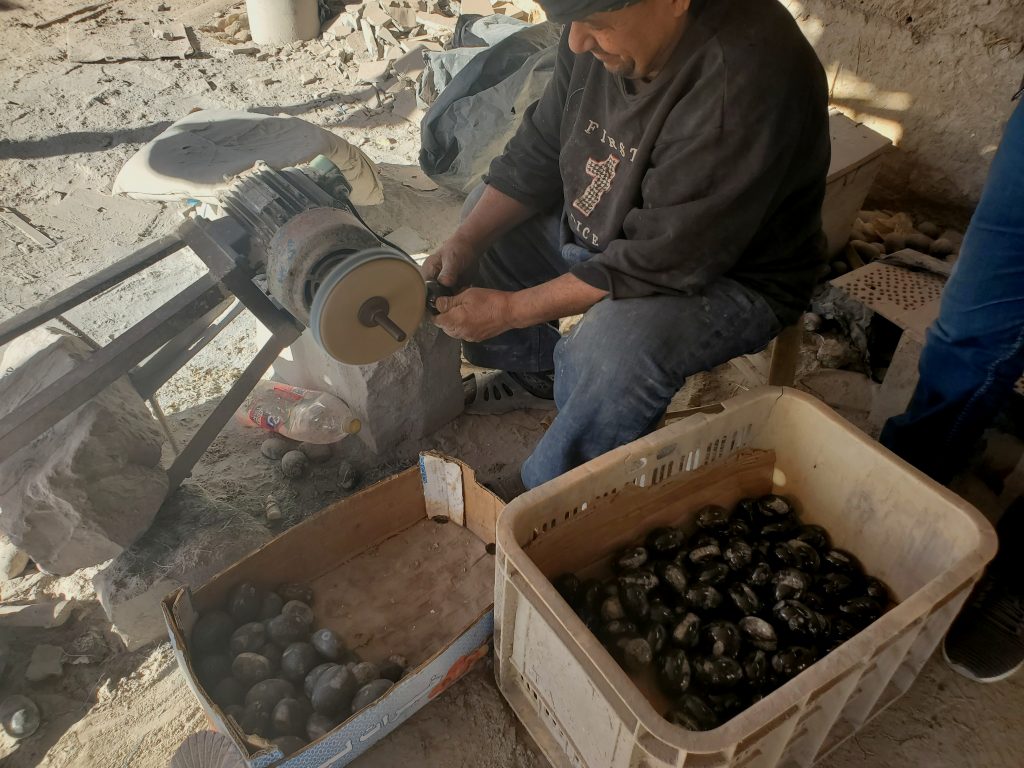
Many hours of driving followed, and I think we all dozed off here and there as we rumbled over scrubby hills studded with bands and lines of limestone, clearly showing its ancient seabed history. Omar woke us as we crossed over the Middle Atlas range, and pointed out the extremely noticeable change from this barren and rocky appearance to a new, more tundra-esque appearance (low, close cropped grasses, far fewer rocks, and now cypress and more oak trees started to appear) on the north slopes of the range. It snows in this region, he pointed out, and gestured to the houses – instead of the typical flat-top roof we’d seen everywhere else, these houses looked downright French, with angled red-tiled roofs. The beautiful city of Irfan was granted a brief stop, as Omar called it one of the most beautiful towns in the entire country, filled with huge ancient trees, cool climate (we were 1,600 meters above sea level), and lots of water. During the French occupation of Morocco this was supposedly a favorite vacation spot of the French military and political leadership to escape the heat of Fes, and they turned what had been a tiny mountain village into a luxurious small city. We had some excellent – and extremely affordable coffees, warm croissants, and cakes in a cafe; the total for the four of our family was the equivalent of $15.
We needed to keep pressing on though, so after I messaged Christine to tell her to look up the cost of buying property in Irfan, onward we rolled. The final stop was of mixed interest – the Gourad Cedar forest, a beautifully dark and dense green expanse, which would have been fine for all of us if it had not been filled with extremely socialized and fearless Atlas Macaques. Vendors surrounded us the minute we exited the van, holding out peanuts or apples or other ‘treats’ that we could feed the monkeys if we wanted to contribute to further, um, “socialization.” One of the largest males with thick-golden brown hair saw us enter the park, and ambled towards us. “Hello,” said Betsy when it was about 20 feet away. It kept coming, not making eye contact (thankfully; everyone knows what that means in primate culture), but clearly having us pegged as potential snack-holders. “Uh…hello?” I said as the monkey now said down at my feet, two feet away. Patiently, like a cat. He glanced up at me, then looked away again politely. He was large compared to the females of his troop, about 3 feet tall I’d estimate, and I had no doubt that despite being half my size, he could do me serious damage if he wanted to. But after I made no moves to toss him peanuts the way the vendors were doing, he shuffled away to find easier marks. Aggressive monkeys are likely dead monkeys when it comes to humans, but our group of American tourists had no interest in making this troop even more interested in human contact. The Moroccan tourists that were also in the park seemed to love it though, buying handfuls of the snacks from the eager vendors and throwing it with wild abandon to the chittering simians. Apparently, the nearby fruit and vegetable farms were of mixed opinion to the native monkeys – sometimes, if the “protection snacks” weren’t “paid” the troops would come out of the forest and help themselves. So as payoff, farmers would bring heaps of their slightly smashed or otherwise unattractive produce to the outskirts of the forest and leave them there, hoping that would be enough to convince their neighbors to leave their fields be.
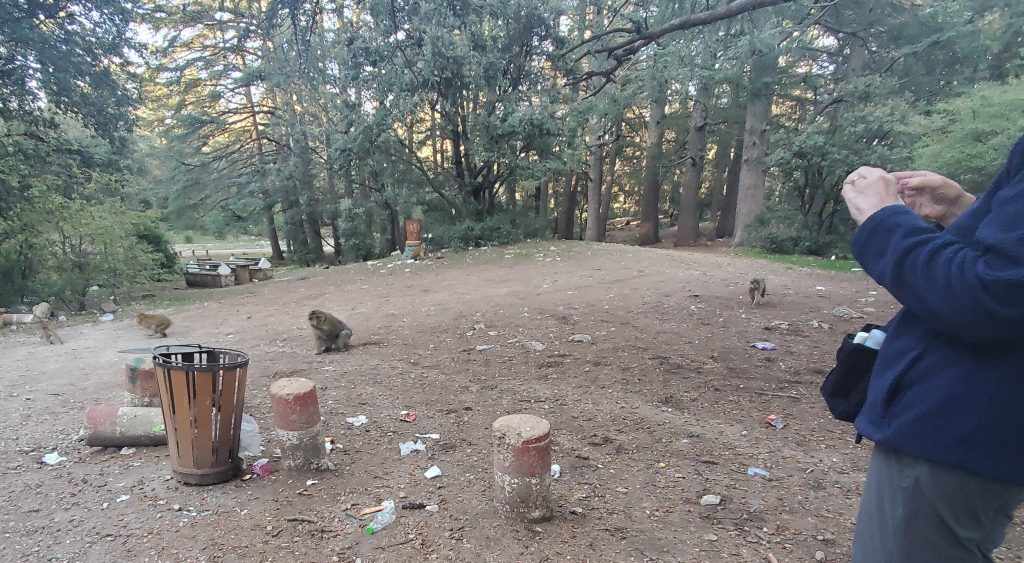
Omar paid a vendor leading a plumed and bedazzled horse 3 USD to climb aboard and be photographed. “I love horses, I’m always very happy to see them,” he smiled. As we walked back to the van, he commented that he wanted to support the local vendors – he wanted them to have an income; to not feel that only the university educated guides like himself who spoke numerous languages would benefit from tourism. I asked about his usage of USD instead of dirhams, and he pointed out that since this area was popular for international visitors, having euros or dollars to give back as change when tourists wanted to buy something was also useful for them.
The sun had just finished setting over the rolling, tree-covered hills when we came over a crest and saw all the lights of the major metropolis of Fes and its suburbs arrayed before us. Our base camp for the next three days would be Palais Faraj hotel, and boy, were we looking forward to getting all the sand of the previous night off of us!


No one has commented on this post - please leave me one, I love getting feedback!
Follow this post's comments, or leave a Trackback from your site